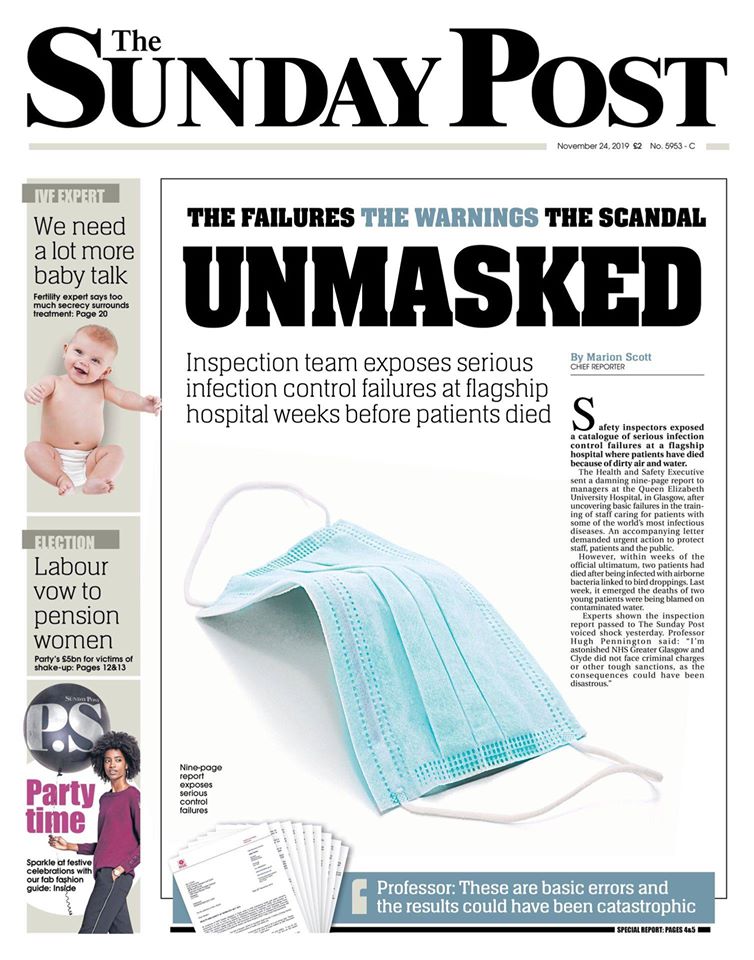
Staff at a hospital where patients died because of dirty air and water were not performing one of the most basic infection control tasks – flushing out the taps.
As patients fought deadly infections at Glasgow’s Queen Elizabeth University Hospital, bosses failed to ensure taps, baths and shower heads were being flushed at least once a day.
Documents seen by The Sunday Post reveal that, even after a water contamination outbreak hit dozens of child cancer patients and one, 10-year-old Milly Main, died after picking up an infection, there was confusion over who was responsible for completing the task.
Inspectors from Health Improvement Scotland made a spot visit in January this year. Their report found the health board had not kept proper records vital to prevent water-borne infections in high-risk wards.
Infection expert professor Hugh Pennington described the failures as “either total incompetence or dereliction of duty”.
He said: “Health professionals have known for many years that these very basic practices can and do prevent infection.
“If these very basic steps had been taken, some of the deaths and infections we’ve seen at this hospital could have been prevented.”
Despite instructions from Scotland’s former Chief Medical Officer dating back to 2013 that all hospital taps must be flushed for at least a minute once a day and detailed records kept, documents show NHS Greater & Clyde failed to do so.
Inspectors found staff were unclear who was responsible for carrying out the flushing routines and records were inconsistent.
The inspectors warned: “At least one section of the audit scored 33%.
“We were concerned assurances would be taken from the overall (aggregated) high score without recognising the low scores within the separate sections.”
They also raised concern that, when senior charge nurses were not available, the senior nurses on duty could not access audit results and action plans.
A nurse was found carrying body fluids to the sluice room without wearing protective clothing to prevent infection.
Despite warnings in 2018 not to use bladeless fans because of infection issues, they were still being used.
Lockable bins were left unlocked and accessible to the public. Staff were handing out food but not complying with hand-washing infection control precautions.
Medical staff were preparing intravenous infusions within splash contamination areas of a sink.
Professor Pennington said: “It’s clear that, with the level of deaths and infections and evidence that even basic measures were not being implemented, things were very wrong.
“While I welcome a public inquiry, my concern is that it could take years and we need to be reassured procedures are being adhered to and patients are protected now.”
His concerns were echoed by Dublin University professor Jack Lambert, a renowned specialist in infectious diseases, who said: “Tap flushing costs nothing to do, but it prevents infections.
“It should be done by responsible health board employees who are properly trained in what to do and how to properly record it.
“All of these dreadful tragedies are the consequence of not putting the proper investment in the training and management of infection control.”
Scottish Conservative shadow health secretary Miles Briggs said: “It’s clear we need an inquiry, but it’s even more clear that we need reassurance the place is safe now.
“And what is being done to ensure this is not happening in other health board areas?”
Anas Sarwar, Labour MSP for Glasgow, said: “This is a damning revelation.
“Parents of very ill children have been unforgivably let down by senior management at this hospital. Those responsible for failing to respond to warning signs must be moved aside so an independent investigation can provide answers for parents.”
A spokeswoman for NHS Greater Glasgow & Clyde said: “The report contained a number of positive findings, including good staff awareness of infection control and high levels of hand hygiene compliance. The inspectors also confirmed that infection rates were within acceptable levels.
“The report did, however, highlight a number of areas we needed to address. Work got under way immediately to action the requirements.
“A follow-up visit took place last week and the report will be published in February.
“We would like to reassure our patients that the prevention and control of infection has always been, and remains, a top priority for NHSGGC.”

Enjoy the convenience of having The Sunday Post delivered as a digital ePaper straight to your smartphone, tablet or computer.
Subscribe for only £5.49 a month and enjoy all the benefits of the printed paper as a digital replica.
Subscribe